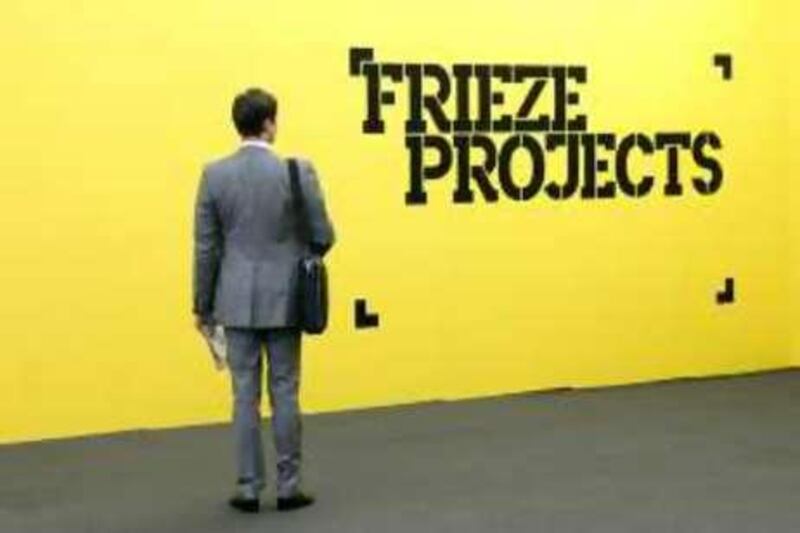With global economic instability showing little sign of abating, Icelandic banks going into receivership and the credit crunch becoming the most overused term in the English lexicon, the mood in the run-up to this year's Frieze Art Fair in London was one of muted panic. Widely regarded as one of the world's most influential art fairs, Frieze, which wrapped up yesterday, attracted 151 galleries representing 27 countries. New work by over 1,000 artists was exhibited. Nonetheless, most conversations revolved around the topic of sales.
At the pre-fair parties, assembled groups chatted excitedly about the golden boy Damien Hirst, the British artist who recently abandoned the traditional method of selling through dealers and galleries by auctioning 223 pieces at Sotheby's. The fact that he made £111 million (Dh705 million) on the same day Lehman Brothers went bust was a much repeated irony. Others grumbled in hushed tones about dot-com analogies and whether the Americans would show.
Speculation was quashed by a fair opening that was rebellious, international and triumphalist. The ever-effusive director of Art Dubai, John Martin, summed up the necessity of being present: "For this one week the art world moves to London like the film world moves to Cannes," he said. Collectors including Charles Saatchi, Daria Zhukova and the actress Gwyneth Paltrow toured the gallery stalls, while Boris Groys, Yoko Ono and Cosey Fanni Tutti were part of an impressive line-up of artists, philosophers, writers and cultural commentators speaking in the Frieze Talks series.
The Middle East had a prominent presence. The Galerie Sfeir-Semler, based in Hamburg and Beirut, focused on its Middle Eastern artists. "I am very happy to exhibit here," said the owner, Andrée Sfeir-Semler. "It is a very interesting and international contemporary art market. We are featuring new work by Walid Raad, including a triptych entitled A History of Modern and Contemporary Arab Art. It uses Arabic calligraphy to produce work that is monochromic. The inkjet on archival paper gives the art the appearance of a series of book covers. The colours are very subtle; they are like traditional elder books and the calligraphy is small on the image, leaving it almost empty. It is conceptual but also minimal."
By lunchtime on the preview day, Sfeir-Semler's gallery had sold a number of works, including a video by Akram Zaatari titled Nature Morte, which features two men preparing for military action. Although the drama is staged, it features a former militia member, Mohammad Abu Hammane, and blurs the boundaries between reality and fiction. Politics and power infiltrate the work, which uses the setting of Hubbariyeh, a Lebanese village located in the Aarqub in South Lebanon only a few kilometres away from the Israeli-occupied Shebaa farms, to focus on issues relating to boundaries and ownership.
Running parallel to Frieze was a series of social events designed to keep spirits high. The much anticipated Christie's and Vanity Fair party celebrated the forthcoming post-war and contemporary art sale, which was held at the auction house. On sale were works by Jeff Koons, Andy Warhol and the Iranian contemporary artist Farhad Moshiri, who turned heads with his sculpture Golden Love Super Deluxe.
"This has been an extraordinary week," said Art Dubai's John Martin. "One of the things that has happened - and it's been something entirely unplanned - is that a number of events have focused on Middle Eastern contemporary art. This represents a real change in attitudes. People are getting excited about what is coming out of the region. Next week, when the circus moves to Paris for the Foire Internationale d'Art Contemporain, the Art Dubai Global Forum will be hosting a discussion panel at the Grand Palais. This is a great UAE export."
"Successful fairs carve out their own identity," remarked Martin, adding that the fair has managed to cultivate a dedicated audience. He hopes that the UAE will follow suit and develop dedicated audiences of its own which are motivated, informed and involved. "The museums that will open in Abu Dhabi will offer a platform for artists in Iran, Beirut, Jordan and Palestine; they will have a significance right across the Middle East. As the quality of our events grows, more artists will use them as a platform for their work. At Art Dubai, we aim to attract an international audience that will use the fair as a way of finding out what is going on in the region. That's what Frieze provides in London."
"As for the issue of economic instability," he continued, "so far the art world is holding up incredibly well and the days of the credit crunch may be quickly forgotten." The collector Andrew Martin agrees. "We aren't worried about the current climate. Largely, those that could afford these works in the past can afford them now."





